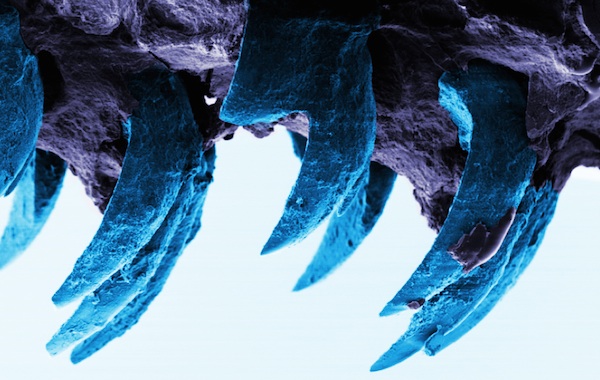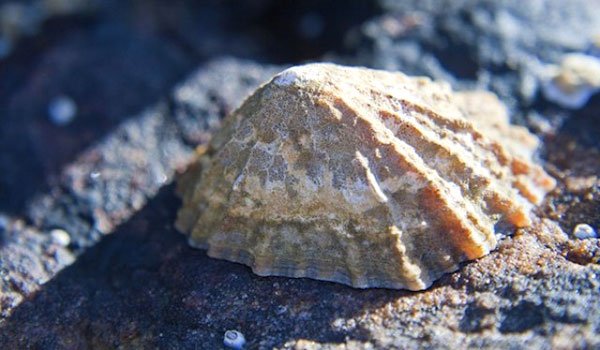Limpets are gastropods like slugs and abalone, and while they hang out on the surface of rocks in shallow water, don't mistake them for barnacles. When the tide is in, limpets feed on algae by scraping along rock surfaces with their tongue-like appendage called the radula. The bottom side of the radula contains a set of teeth that are constantly exposed to tremendous forces as the critter rasps across hard, jagged surfaces.
A team led by Asa Barber from the University of Portsmouth collected samples of the limpetPatella vulgata in Southampton, U.K. and found that their teeth contain a hard, iron-containing mineral called goethite, which forms in the animal as it grows. Furthermore, these thin, tightly-packed fibers of goethite are encased in protein.
To measure the strength of this resilient composite structure, the team turned to atomic force microscopy, a technique used to pull materials apart at the level of an atom. Limpet teeth, they found, have one of highest known strengths—exceeding that of many engineering alloys even. The amount of force it can withstand before breaking (called the tensile strength) ranged from 3.0 to 6.5 gigapascals (GPa). That’s comparable to a single string of spaghetti holding up 3,000 half-kilogram (1.1 lbs) bags of sugar, BBC explains.
“Generally a big structure has lots of flaws and can break more easily than a smaller structure, which has fewer flaws and is stronger,” Barber says in a news release. “The problem is that most structures have to be fairly big so they’re weaker than we would like. Limpet teeth break this rule as their strength is the same no matter what the size.”
The whole tooth is slightly less than a millimeter long but it’s curved, and its strength and resistance to failure (even while grinding on rocky surfaces) is dependent on both the shape of the tooth and the material. What’s stronger than spider silk? Limpet teeth! And what’s a limpet? They’re small aquatic snails with wide, conical shells. Their tiny, millimeter-long teeth are now the record holders for the world's strongest natural material, according to findings published in the Journal of the Royal Society Interface this week.
Limpets are gastropods like slugs and abalone, and while they hang out on the surface of rocks in shallow water, don't mistake them for barnacles. When the tide is in, limpets feed on algae by scraping along rock surfaces with their tongue-like appendage called the radula. The bottom side of the radula contains a set of teeth that are constantly exposed to tremendous forces as the critter rasps across hard, jagged surfaces.
A team led by Asa Barber from the University of Portsmouth collected samples of the limpetPatella vulgata in Southampton, U.K. and found that their teeth contain a hard, iron-containing mineral called goethite, which forms in the animal as it grows. Furthermore, these thin, tightly-packed fibers of goethite are encased in protein.
To measure the strength of this resilient composite structure, the team turned to atomic force microscopy, a technique used to pull materials apart at the level of an atom. Limpet teeth, they found, have one of highest known strengths—exceeding that of many engineering alloys even. The amount of force it can withstand before breaking (called the tensile strength) ranged from 3.0 to 6.5 gigapascals (GPa). That’s comparable to a single string of spaghetti holding up 3,000 half-kilogram (1.1 lbs) bags of sugar, BBC explains.
“Generally a big structure has lots of flaws and can break more easily than a smaller structure, which has fewer flaws and is stronger,” Barber says in a news release. “The problem is that most structures have to be fairly big so they’re weaker than we would like. Limpet teeth break this rule as their strength is the same no matter what the size.”
The whole tooth is slightly less than a millimeter long but it’s curved, and its strength and resistance to failure (even while grinding on rocky surfaces) is dependent on both the shape of the tooth and the material. A scanning electron microscope image of limpet teeth is shown below.
“Until now we thought that spider silk was the strongest biological material because of its super-strength and potential applications in everything from bullet-proof vests to computer electronics,” Barber adds. For comparison, spider silk has a tensile strength of 1.3 GPa,Science reports. "This discovery," Barber adds, "means that the fibrous structures found in limpet teeth could be mimicked and used in high-performance engineering applications such as Formula 1 racing cars, the hulls of boats and aircraft structures."
(iflscience.com)







